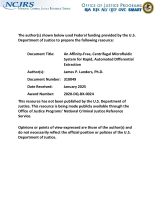DNA (Deoxyribonucleic Acid)
Optimization of Primer-specific Filter Metrics for the Assessment of Mitochondrial DNA Sequence Data
Date Published
December 2010
Agencies
NIJ-Sponsored
Evaluation of Alternative Methods for DNA Recovery of Compromised Skeletal Remains
Date Published
2024
Agencies
NIJ-Sponsored
Exploring the Relationship between Aptamer Binding Thermodynamics, Affinity, and Specificity
NCJ Number
310353
Journal
Nucleic Acids Research
Date Published
March 2025
Agencies
NIJ-Sponsored
Publication Link
DNA Metabarcoding Using Indexed Primers: Workflow to Characterize Bacteria, Fungi, Plants, and Arthropods from Environmental Samples
NCJ Number
310322
Journal
Diversity
Date Published
February 2025
Agencies
NIJ-Sponsored
Publication Link
Benchmarking for Genotyping and Imputation Using Degraded DNA for Forensic Applications across Diverse Populations
NCJ Number
310320
Journal
Forensic Science International: Genetics
Date Published
February 2025
Agencies
NIJ-Sponsored
Publication Link
Improved DNA Recovery and STR Profile Development from Weathered Bos Taurus Bones using Demineralized Bone Slices
NCJ Number
310311
Journal
Journal of Forensic Sciences
Date Published
March 2025
Agencies
NIJ-Sponsored
Publication Link
An Affinity-Free, Centrifugal Microfluidic System for Rapid, Automated Differential Extraction
Date Published
November 2024
Agencies
NIJ-Sponsored




